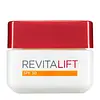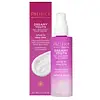What's inside
What's inside
 Key Ingredients
Key Ingredients

 Benefits
Benefits

 Concerns
Concerns

 Ingredients Side-by-side
Ingredients Side-by-side

Water
Skin ConditioningGlycerin
HumectantEthylhexyl Salicylate
UV AbsorberDimethicone
EmollientAlcohol Denat.
AntimicrobialOctocrylene
UV AbsorberNylon-12
Butyl Methoxydibenzoylmethane
UV AbsorberOctyldodecanol
EmollientPhenylbenzimidazole Sulfonic Acid
UV AbsorberCetyl Alcohol
EmollientBehenyl Alcohol
EmollientTriethanolamine
BufferingIsopropyl Isostearate
EmollientHydrolyzed Soy Protein
HumectantAcetyl Trifluoromethylphenyl Valylglycine
Skin ConditioningAdenosine
Skin ConditioningCapryloyl Salicylic Acid
ExfoliatingDisodium EDTA
Faex Extract
Skin ConditioningSalicyloyl Phytosphingosine
Skin ConditioningRetinyl Palmitate
Skin ConditioningAcrylamide/Sodium Acryloyldimethyltaurate Copolymer
Emulsion StabilisingAluminum Starch Octenylsuccinate
AbsorbentAmmonium Polyacryloyldimethyl Taurate
Emulsion StabilisingCetearyl Alcohol
EmollientCetearyl Glucoside
EmulsifyingDisodium Stearoyl Glutamate
CleansingHydroxyethyl Acrylate/Sodium Acryloyldimethyl Taurate Copolymer
Emulsion StabilisingIsohexadecane
EmollientMyristic Acid
CleansingPalmitic Acid
EmollientPEG-100 Stearate
Pentylene Glycol
Skin ConditioningPoly C10-30 Alkyl Acrylate
Emulsion StabilisingPolyethylene
AbrasivePolysorbate 60
EmulsifyingPolysorbate 80
EmulsifyingSorbitan Isostearate
EmulsifyingSorbitan Oleate
EmulsifyingStearic Acid
CleansingSilica
AbrasiveTitanium Dioxide
Cosmetic ColorantAlpha-Isomethyl Ionone
PerfumingBenzyl Alcohol
PerfumingBenzyl Salicylate
PerfumingCitronellol
PerfumingGeraniol
PerfumingHexyl Cinnamal
PerfumingLimonene
PerfumingLinalool
PerfumingCI 15510
Cosmetic ColorantPhenoxyethanol
PreservativeTocopherol
AntioxidantParfum
MaskingWater, Glycerin, Ethylhexyl Salicylate, Dimethicone, Alcohol Denat., Octocrylene, Nylon-12, Butyl Methoxydibenzoylmethane, Octyldodecanol, Phenylbenzimidazole Sulfonic Acid, Cetyl Alcohol, Behenyl Alcohol, Triethanolamine, Isopropyl Isostearate, Hydrolyzed Soy Protein, Acetyl Trifluoromethylphenyl Valylglycine, Adenosine, Capryloyl Salicylic Acid, Disodium EDTA, Faex Extract, Salicyloyl Phytosphingosine, Retinyl Palmitate, Acrylamide/Sodium Acryloyldimethyltaurate Copolymer, Aluminum Starch Octenylsuccinate, Ammonium Polyacryloyldimethyl Taurate, Cetearyl Alcohol, Cetearyl Glucoside, Disodium Stearoyl Glutamate, Hydroxyethyl Acrylate/Sodium Acryloyldimethyl Taurate Copolymer, Isohexadecane, Myristic Acid, Palmitic Acid, PEG-100 Stearate, Pentylene Glycol, Poly C10-30 Alkyl Acrylate, Polyethylene, Polysorbate 60, Polysorbate 80, Sorbitan Isostearate, Sorbitan Oleate, Stearic Acid, Silica, Titanium Dioxide, Alpha-Isomethyl Ionone, Benzyl Alcohol, Benzyl Salicylate, Citronellol, Geraniol, Hexyl Cinnamal, Limonene, Linalool, CI 15510, Phenoxyethanol, Tocopherol, Parfum
Water
Skin ConditioningHelianthus Annuus Seed Oil
EmollientEthylhexylglyceryl Palmitate
EmulsifyingAcetyl Hexapeptide-8
HumectantGlyceryl Stearate
EmollientCetyl Alcohol
EmollientPalmitoyl Tripeptide-3
Butyrospermum Parkii Oil
EmollientVitis Vinifera Seed Oil
EmollientAloe Barbadensis Leaf Juice
Skin ConditioningLaminaria Hyperborea Extract
Skin ProtectingTocopheryl Acetate
AntioxidantMagnesium Ascorbyl Phosphate
AntioxidantPrunus Amygdalus Dulcis Oil
Skin ConditioningHyaluronic Acid
HumectantTheobroma Cacao Seed Butter
EmollientPanthenol
Skin ConditioningAllantoin
Skin ConditioningXanthan Gum
EmulsifyingAlgin
MaskingAvena Sativa Bran
AbrasiveCocos Nucifera Water
MaskingIris Pallida Leaf Cell Extract
AntioxidantRosa Damascena Leaf Cell Extract
Skin ProtectingCichorium Intybus Root Oligosaccharides
Skin ConditioningCaesalpinia Spinosa Gum
Skin ConditioningCucumis Sativus Fruit Extract
EmollientPhenoxyethanol
PreservativeEthylhexylglycerin
Skin ConditioningPelargonium Graveolens Oil
MaskingWater, Helianthus Annuus Seed Oil, Ethylhexylglyceryl Palmitate, Acetyl Hexapeptide-8, Glyceryl Stearate, Cetyl Alcohol, Palmitoyl Tripeptide-3, Butyrospermum Parkii Oil, Vitis Vinifera Seed Oil, Aloe Barbadensis Leaf Juice, Laminaria Hyperborea Extract, Tocopheryl Acetate, Magnesium Ascorbyl Phosphate, Prunus Amygdalus Dulcis Oil, Hyaluronic Acid, Theobroma Cacao Seed Butter, Panthenol, Allantoin, Xanthan Gum, Algin, Avena Sativa Bran, Cocos Nucifera Water, Iris Pallida Leaf Cell Extract, Rosa Damascena Leaf Cell Extract, Cichorium Intybus Root Oligosaccharides, Caesalpinia Spinosa Gum, Cucumis Sativus Fruit Extract, Phenoxyethanol, Ethylhexylglycerin, Pelargonium Graveolens Oil
Ingredients Explained
These ingredients are found in both products.
Ingredients higher up in an ingredient list are typically present in a larger amount.
Cetyl Alcohol is a fatty alcohol. Fatty Alcohols are most often used as an emollient or to thicken a product.
Its main roles are:
Though it has "alcohol" in the name, it is not related to denatured alcohol or ethyl alcohol.
The FDA allows products labeled "alcohol-free" to have fatty alcohols.
Learn more about Cetyl AlcoholPhenoxyethanol is a preservative that has germicide, antimicrobial, and aromatic properties. Studies show that phenoxyethanol can prevent microbial growth. By itself, it has a scent that is similar to that of a rose.
It's often used in formulations along with Caprylyl Glycol to preserve the shelf life of products.
Water. It's the most common cosmetic ingredient of all. You'll usually see it at the top of ingredient lists, meaning that it makes up the largest part of the product.
So why is it so popular? Water most often acts as a solvent - this means that it helps dissolve other ingredients into the formulation.
You'll also recognize water as that liquid we all need to stay alive. If you see this, drink a glass of water. Stay hydrated!
Learn more about Water